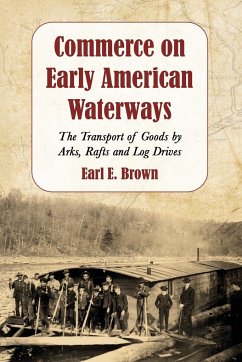Earl E. Brown
Commerce on Early American Waterways
The Transport of Goods by Arks, Rafts and Log Drives
Earl E. Brown
Commerce on Early American Waterways
The Transport of Goods by Arks, Rafts and Log Drives
- Broschiertes Buch
- Merkliste
- Auf die Merkliste
- Bewerten Bewerten
- Teilen
- Produkt teilen
- Produkterinnerung
- Produkterinnerung
Colonial pioneers began entering the logging and forestry industries in great numbers along the Allegheny and Appalachian mountains during the late 1700s and were soon producing much more product than they could use. This book details how settlers used waterways to transport products to coastal markets. Topics include the timeline of water craft construction; major figures in the development of early waterway transportation; types of goods transported; and occupational hazards from raging rapids to snowstorms. The book also features photographs, charts, and diary excerpts and an appendix detailing ark and raft construction.…mehr
Andere Kunden interessierten sich auch für
![The Commerce and Other Business of the Waterways of the State of New York [microform] ... A Tabulation of Facts About Waterborne Trade .. The Commerce and Other Business of the Waterways of the State of New York [microform] ... A Tabulation of Facts About Waterborne Trade ..]() The Commerce and Other Business of the Waterways of the State of New York [microform] ... A Tabulation of Facts About Waterborne Trade ..18,99 €
The Commerce and Other Business of the Waterways of the State of New York [microform] ... A Tabulation of Facts About Waterborne Trade ..18,99 €![Deeper Waterways From the Great Lakes to the Atlantic [microform]: Reports of the Canadian Members of the International Commission Deeper Waterways From the Great Lakes to the Atlantic [microform]: Reports of the Canadian Members of the International Commission]() Deeper Waterways From the Great Lakes to the Atlantic [microform]: Reports of the Canadian Members of the International Commission18,99 €
Deeper Waterways From the Great Lakes to the Atlantic [microform]: Reports of the Canadian Members of the International Commission18,99 €![The Great American Steamboat Race The Great American Steamboat Race]() Benton Rain PattersonThe Great American Steamboat Race45,99 €
Benton Rain PattersonThe Great American Steamboat Race45,99 €![The French Assault on American Shipping, 1793-1813 The French Assault on American Shipping, 1793-1813]() Greg H. WilliamsThe French Assault on American Shipping, 1793-1813113,99 €
Greg H. WilliamsThe French Assault on American Shipping, 1793-1813113,99 €![Charles Wilkes and the Exploration of Inland Washington Waters Charles Wilkes and the Exploration of Inland Washington Waters]() Charles Wilkes and the Exploration of Inland Washington Waters52,99 €
Charles Wilkes and the Exploration of Inland Washington Waters52,99 €![Electric Boats and Ships Electric Boats and Ships]() Kevin DesmondElectric Boats and Ships49,99 €
Kevin DesmondElectric Boats and Ships49,99 €![Discovering the North-West Passage Discovering the North-West Passage]() Glenn M. SteinDiscovering the North-West Passage49,99 €
Glenn M. SteinDiscovering the North-West Passage49,99 €-
-
-
Colonial pioneers began entering the logging and forestry industries in great numbers along the Allegheny and Appalachian mountains during the late 1700s and were soon producing much more product than they could use. This book details how settlers used waterways to transport products to coastal markets. Topics include the timeline of water craft construction; major figures in the development of early waterway transportation; types of goods transported; and occupational hazards from raging rapids to snowstorms. The book also features photographs, charts, and diary excerpts and an appendix detailing ark and raft construction.
Hinweis: Dieser Artikel kann nur an eine deutsche Lieferadresse ausgeliefert werden.
Hinweis: Dieser Artikel kann nur an eine deutsche Lieferadresse ausgeliefert werden.
Produktdetails
- Produktdetails
- Verlag: McFarland
- Seitenzahl: 242
- Erscheinungstermin: 1. April 2010
- Englisch
- Abmessung: 229mm x 152mm x 14mm
- Gewicht: 399g
- ISBN-13: 9780786447428
- ISBN-10: 0786447427
- Artikelnr.: 28179809
- Herstellerkennzeichnung
- Libri GmbH
- Europaallee 1
- 36244 Bad Hersfeld
- gpsr@libri.de
- Verlag: McFarland
- Seitenzahl: 242
- Erscheinungstermin: 1. April 2010
- Englisch
- Abmessung: 229mm x 152mm x 14mm
- Gewicht: 399g
- ISBN-13: 9780786447428
- ISBN-10: 0786447427
- Artikelnr.: 28179809
- Herstellerkennzeichnung
- Libri GmbH
- Europaallee 1
- 36244 Bad Hersfeld
- gpsr@libri.de
Earl E. Brown, a retired Marine officer and Naval Aviator, with an M.S. in Operation Research and System Analysis, directed studies for the national government. He has previously published on water commerce in Colonial America.
Table of Contents
Acknowledgments
Preface
Introduction: The Use of Rivers and Streams to Transport Heavy Loads to
Market
1. Early Colonial America
The Beginning
Rafts, Durham Boats and Conestoga Wagons
Philadelphia
Baltimore and the Susquehanna Valley
The French and Indian War
The Quakers Lose Control of the Pennsylvania Assembly
Baltimore
Between the Wars
The Revolutionary War 1776-1783
Pennsylvania
Baltimore
After the Revolutionary War
Pennsylvania
Middletown, York Haven and Columbia
Baltimore
2. The Susquehanna Is Opened to the Chesapeake Bay Cryder's Run
3. Arks on the Penns Creek
The Creek
Building a Dam Across a Public Highway
Three Sides to the Chute Controversy
Ark Navigation
Butter Rock
Ark Stoving (Wrecking)
Ark Cargos
The Costs to Get Products to Market
What Was 180,000 Bushels of Wheat Worth?
Warehouses, Landings and Ark Construction
Penns Valley Arks
The Manufacturing of Wheat
4. Waterways from 1791 to the Early 1800s
Arks and Rafts in New York State
Before the War of 1812
Vying for the Susquehanna River Trade
The Steamboat
Baltimore During the War of 1812
Arks on Other Public Highways
The West Branch of the Susquehanna River
The North Branch of the Susquehanna River
The Lehigh River
The Main Branch of the Susquehanna River
Baltimore after the War of 1812
The Canals
5. Rafting on the North Branch
Strong's Journal
Strong's Voyage
Thomas Yates' Charts
6. Rafting on the Main Branches
The Shamokin Dam
Simon Girty
Lazy Man's Gap
Lower River Pilots
Conewago Falls
Susquehanna Gorge
Port Deposit, Maryland
Jacob Tome's Port Deposit
William Lowman: a Waterman's Life in Port Deposit
Dancing over the Columbia Dam
7. Rafts on the West Branch
William Langdon: 1855
8. Tales of the West Branch
Getting Stuck on a Rock
Rafting Grub
Danger at Shamokin Dam
A Tragedy at Millers Landing
Caught in a Spring Snowstorm
A Rafting Town in Season
Cherry Tree Joe
Ladies on the River
My First Rafting Trip
Gallows Harbor: How it Got its Name
9. Log Driving
Log Drive to Williamsport in 1868
John Dubois and Hiram Woodward
The Woodhicks
The Raftsmen and Log Drivers' Relationships
Log Rustlers
The Camps
Camp Dubois Opens
The Jobber
Felling and Skidding
Parties along the Sinnemahoning Creek
How the Number of Logs Was Estimated
How the Drive Was Organized
The Drive Begins
Tragedy on the River
On to Williamsport
West Branch Log Drives
10. Woodhicks
Jam Breakers
Woodhick Baseball
Bullies
Abe Bloom
Miles Dent
Ambrose Campbell and Len Childs
Big Bob Gowdy
11. The Mississippi Watershed
Early Road West
The Allegheny and Ohio Rivers
The Mississippi River
Appendix: Arks and Raft construction
Ark Construction
Board Raft Construction
Manufacturing Sticks
Manufacturing a Stick into a Spar
Manufacturing a Stick into a Square Timber
Building a Hauling or Skidding Road
Hauling or Skidding Spars
Landings or Rafting Grounds
Oars or Sweeps
Rafting-in a Spar Raft
Rafting-in a Square Timber Raft
Double Bowing
Landing and Snubbing Rafts
Rafting Shanties
Rafting-in a Round Log Raft
Log Slide Construction
Glossary
Works Cited
Index
Acknowledgments
Preface
Introduction: The Use of Rivers and Streams to Transport Heavy Loads to
Market
1. Early Colonial America
The Beginning
Rafts, Durham Boats and Conestoga Wagons
Philadelphia
Baltimore and the Susquehanna Valley
The French and Indian War
The Quakers Lose Control of the Pennsylvania Assembly
Baltimore
Between the Wars
The Revolutionary War 1776-1783
Pennsylvania
Baltimore
After the Revolutionary War
Pennsylvania
Middletown, York Haven and Columbia
Baltimore
2. The Susquehanna Is Opened to the Chesapeake Bay Cryder's Run
3. Arks on the Penns Creek
The Creek
Building a Dam Across a Public Highway
Three Sides to the Chute Controversy
Ark Navigation
Butter Rock
Ark Stoving (Wrecking)
Ark Cargos
The Costs to Get Products to Market
What Was 180,000 Bushels of Wheat Worth?
Warehouses, Landings and Ark Construction
Penns Valley Arks
The Manufacturing of Wheat
4. Waterways from 1791 to the Early 1800s
Arks and Rafts in New York State
Before the War of 1812
Vying for the Susquehanna River Trade
The Steamboat
Baltimore During the War of 1812
Arks on Other Public Highways
The West Branch of the Susquehanna River
The North Branch of the Susquehanna River
The Lehigh River
The Main Branch of the Susquehanna River
Baltimore after the War of 1812
The Canals
5. Rafting on the North Branch
Strong's Journal
Strong's Voyage
Thomas Yates' Charts
6. Rafting on the Main Branches
The Shamokin Dam
Simon Girty
Lazy Man's Gap
Lower River Pilots
Conewago Falls
Susquehanna Gorge
Port Deposit, Maryland
Jacob Tome's Port Deposit
William Lowman: a Waterman's Life in Port Deposit
Dancing over the Columbia Dam
7. Rafts on the West Branch
William Langdon: 1855
8. Tales of the West Branch
Getting Stuck on a Rock
Rafting Grub
Danger at Shamokin Dam
A Tragedy at Millers Landing
Caught in a Spring Snowstorm
A Rafting Town in Season
Cherry Tree Joe
Ladies on the River
My First Rafting Trip
Gallows Harbor: How it Got its Name
9. Log Driving
Log Drive to Williamsport in 1868
John Dubois and Hiram Woodward
The Woodhicks
The Raftsmen and Log Drivers' Relationships
Log Rustlers
The Camps
Camp Dubois Opens
The Jobber
Felling and Skidding
Parties along the Sinnemahoning Creek
How the Number of Logs Was Estimated
How the Drive Was Organized
The Drive Begins
Tragedy on the River
On to Williamsport
West Branch Log Drives
10. Woodhicks
Jam Breakers
Woodhick Baseball
Bullies
Abe Bloom
Miles Dent
Ambrose Campbell and Len Childs
Big Bob Gowdy
11. The Mississippi Watershed
Early Road West
The Allegheny and Ohio Rivers
The Mississippi River
Appendix: Arks and Raft construction
Ark Construction
Board Raft Construction
Manufacturing Sticks
Manufacturing a Stick into a Spar
Manufacturing a Stick into a Square Timber
Building a Hauling or Skidding Road
Hauling or Skidding Spars
Landings or Rafting Grounds
Oars or Sweeps
Rafting-in a Spar Raft
Rafting-in a Square Timber Raft
Double Bowing
Landing and Snubbing Rafts
Rafting Shanties
Rafting-in a Round Log Raft
Log Slide Construction
Glossary
Works Cited
Index
Table of Contents
Acknowledgments
Preface
Introduction: The Use of Rivers and Streams to Transport Heavy Loads to
Market
1. Early Colonial America
The Beginning
Rafts, Durham Boats and Conestoga Wagons
Philadelphia
Baltimore and the Susquehanna Valley
The French and Indian War
The Quakers Lose Control of the Pennsylvania Assembly
Baltimore
Between the Wars
The Revolutionary War 1776-1783
Pennsylvania
Baltimore
After the Revolutionary War
Pennsylvania
Middletown, York Haven and Columbia
Baltimore
2. The Susquehanna Is Opened to the Chesapeake Bay Cryder's Run
3. Arks on the Penns Creek
The Creek
Building a Dam Across a Public Highway
Three Sides to the Chute Controversy
Ark Navigation
Butter Rock
Ark Stoving (Wrecking)
Ark Cargos
The Costs to Get Products to Market
What Was 180,000 Bushels of Wheat Worth?
Warehouses, Landings and Ark Construction
Penns Valley Arks
The Manufacturing of Wheat
4. Waterways from 1791 to the Early 1800s
Arks and Rafts in New York State
Before the War of 1812
Vying for the Susquehanna River Trade
The Steamboat
Baltimore During the War of 1812
Arks on Other Public Highways
The West Branch of the Susquehanna River
The North Branch of the Susquehanna River
The Lehigh River
The Main Branch of the Susquehanna River
Baltimore after the War of 1812
The Canals
5. Rafting on the North Branch
Strong's Journal
Strong's Voyage
Thomas Yates' Charts
6. Rafting on the Main Branches
The Shamokin Dam
Simon Girty
Lazy Man's Gap
Lower River Pilots
Conewago Falls
Susquehanna Gorge
Port Deposit, Maryland
Jacob Tome's Port Deposit
William Lowman: a Waterman's Life in Port Deposit
Dancing over the Columbia Dam
7. Rafts on the West Branch
William Langdon: 1855
8. Tales of the West Branch
Getting Stuck on a Rock
Rafting Grub
Danger at Shamokin Dam
A Tragedy at Millers Landing
Caught in a Spring Snowstorm
A Rafting Town in Season
Cherry Tree Joe
Ladies on the River
My First Rafting Trip
Gallows Harbor: How it Got its Name
9. Log Driving
Log Drive to Williamsport in 1868
John Dubois and Hiram Woodward
The Woodhicks
The Raftsmen and Log Drivers' Relationships
Log Rustlers
The Camps
Camp Dubois Opens
The Jobber
Felling and Skidding
Parties along the Sinnemahoning Creek
How the Number of Logs Was Estimated
How the Drive Was Organized
The Drive Begins
Tragedy on the River
On to Williamsport
West Branch Log Drives
10. Woodhicks
Jam Breakers
Woodhick Baseball
Bullies
Abe Bloom
Miles Dent
Ambrose Campbell and Len Childs
Big Bob Gowdy
11. The Mississippi Watershed
Early Road West
The Allegheny and Ohio Rivers
The Mississippi River
Appendix: Arks and Raft construction
Ark Construction
Board Raft Construction
Manufacturing Sticks
Manufacturing a Stick into a Spar
Manufacturing a Stick into a Square Timber
Building a Hauling or Skidding Road
Hauling or Skidding Spars
Landings or Rafting Grounds
Oars or Sweeps
Rafting-in a Spar Raft
Rafting-in a Square Timber Raft
Double Bowing
Landing and Snubbing Rafts
Rafting Shanties
Rafting-in a Round Log Raft
Log Slide Construction
Glossary
Works Cited
Index
Acknowledgments
Preface
Introduction: The Use of Rivers and Streams to Transport Heavy Loads to
Market
1. Early Colonial America
The Beginning
Rafts, Durham Boats and Conestoga Wagons
Philadelphia
Baltimore and the Susquehanna Valley
The French and Indian War
The Quakers Lose Control of the Pennsylvania Assembly
Baltimore
Between the Wars
The Revolutionary War 1776-1783
Pennsylvania
Baltimore
After the Revolutionary War
Pennsylvania
Middletown, York Haven and Columbia
Baltimore
2. The Susquehanna Is Opened to the Chesapeake Bay Cryder's Run
3. Arks on the Penns Creek
The Creek
Building a Dam Across a Public Highway
Three Sides to the Chute Controversy
Ark Navigation
Butter Rock
Ark Stoving (Wrecking)
Ark Cargos
The Costs to Get Products to Market
What Was 180,000 Bushels of Wheat Worth?
Warehouses, Landings and Ark Construction
Penns Valley Arks
The Manufacturing of Wheat
4. Waterways from 1791 to the Early 1800s
Arks and Rafts in New York State
Before the War of 1812
Vying for the Susquehanna River Trade
The Steamboat
Baltimore During the War of 1812
Arks on Other Public Highways
The West Branch of the Susquehanna River
The North Branch of the Susquehanna River
The Lehigh River
The Main Branch of the Susquehanna River
Baltimore after the War of 1812
The Canals
5. Rafting on the North Branch
Strong's Journal
Strong's Voyage
Thomas Yates' Charts
6. Rafting on the Main Branches
The Shamokin Dam
Simon Girty
Lazy Man's Gap
Lower River Pilots
Conewago Falls
Susquehanna Gorge
Port Deposit, Maryland
Jacob Tome's Port Deposit
William Lowman: a Waterman's Life in Port Deposit
Dancing over the Columbia Dam
7. Rafts on the West Branch
William Langdon: 1855
8. Tales of the West Branch
Getting Stuck on a Rock
Rafting Grub
Danger at Shamokin Dam
A Tragedy at Millers Landing
Caught in a Spring Snowstorm
A Rafting Town in Season
Cherry Tree Joe
Ladies on the River
My First Rafting Trip
Gallows Harbor: How it Got its Name
9. Log Driving
Log Drive to Williamsport in 1868
John Dubois and Hiram Woodward
The Woodhicks
The Raftsmen and Log Drivers' Relationships
Log Rustlers
The Camps
Camp Dubois Opens
The Jobber
Felling and Skidding
Parties along the Sinnemahoning Creek
How the Number of Logs Was Estimated
How the Drive Was Organized
The Drive Begins
Tragedy on the River
On to Williamsport
West Branch Log Drives
10. Woodhicks
Jam Breakers
Woodhick Baseball
Bullies
Abe Bloom
Miles Dent
Ambrose Campbell and Len Childs
Big Bob Gowdy
11. The Mississippi Watershed
Early Road West
The Allegheny and Ohio Rivers
The Mississippi River
Appendix: Arks and Raft construction
Ark Construction
Board Raft Construction
Manufacturing Sticks
Manufacturing a Stick into a Spar
Manufacturing a Stick into a Square Timber
Building a Hauling or Skidding Road
Hauling or Skidding Spars
Landings or Rafting Grounds
Oars or Sweeps
Rafting-in a Spar Raft
Rafting-in a Square Timber Raft
Double Bowing
Landing and Snubbing Rafts
Rafting Shanties
Rafting-in a Round Log Raft
Log Slide Construction
Glossary
Works Cited
Index


![The Commerce and Other Business of the Waterways of the State of New York [microform] ... A Tabulation of Facts About Waterborne Trade .. The Commerce and Other Business of the Waterways of the State of New York [microform] ... A Tabulation of Facts About Waterborne Trade ..](https://bilder.buecher.de/produkte/66/66162/66162564m.jpg)
![Deeper Waterways From the Great Lakes to the Atlantic [microform]: Reports of the Canadian Members of the International Commission Deeper Waterways From the Great Lakes to the Atlantic [microform]: Reports of the Canadian Members of the International Commission](https://bilder.buecher.de/produkte/66/66194/66194217m.jpg)




